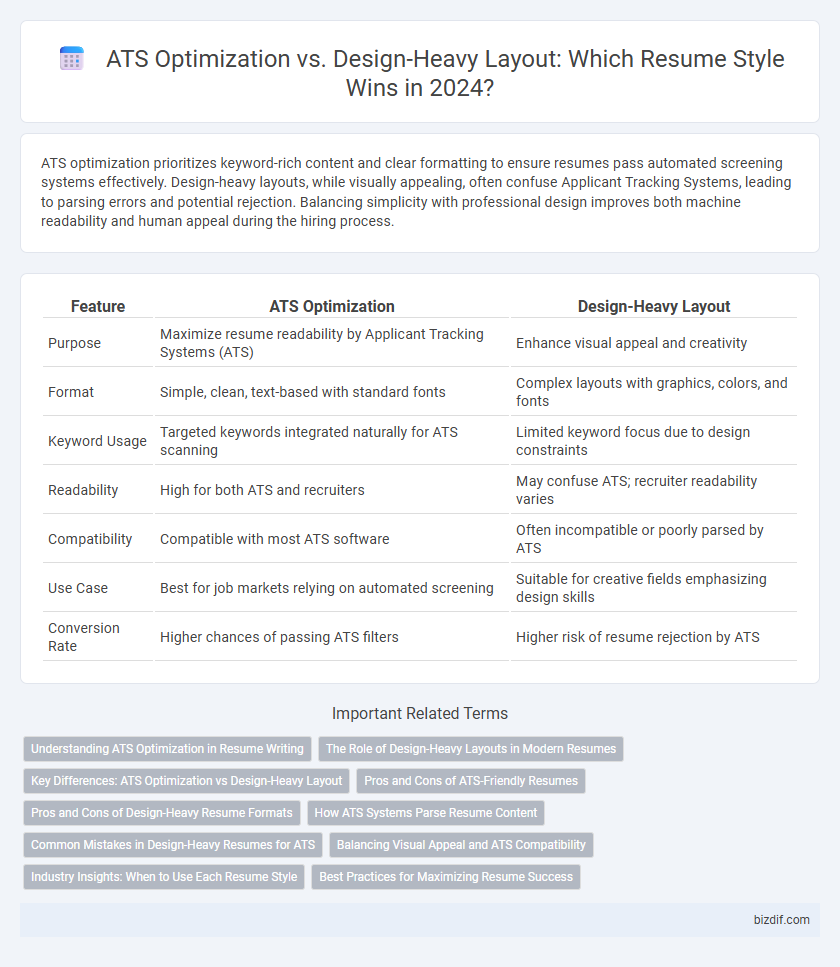ATS optimization prioritizes keyword-rich content and clear formatting to ensure resumes pass automated screening systems effectively. Design-heavy layouts, while visually appealing, often confuse Applicant Tracking Systems, leading to parsing errors and potential rejection. Balancing simplicity with professional design improves both machine readability and human appeal during the hiring process.
Table of Comparison
| Feature | ATS Optimization | Design-Heavy Layout |
|---|---|---|
| Purpose | Maximize resume readability by Applicant Tracking Systems (ATS) | Enhance visual appeal and creativity |
| Format | Simple, clean, text-based with standard fonts | Complex layouts with graphics, colors, and fonts |
| Keyword Usage | Targeted keywords integrated naturally for ATS scanning | Limited keyword focus due to design constraints |
| Readability | High for both ATS and recruiters | May confuse ATS; recruiter readability varies |
| Compatibility | Compatible with most ATS software | Often incompatible or poorly parsed by ATS |
| Use Case | Best for job markets relying on automated screening | Suitable for creative fields emphasizing design skills |
| Conversion Rate | Higher chances of passing ATS filters | Higher risk of resume rejection by ATS |
Understanding ATS Optimization in Resume Writing
Understanding ATS optimization in resume writing is crucial for ensuring your resume passes through automated screening systems that many employers use. ATS-friendly resumes prioritize simple formatting, relevant keywords, and clear section headings, enhancing the chances of your application being noticed. Design-heavy layouts with complex graphics, tables, or unusual fonts often confuse ATS software, leading to misinterpretation or rejection of your resume.
The Role of Design-Heavy Layouts in Modern Resumes
Design-heavy layouts in modern resumes enhance visual appeal and highlight key skills through creative typography and strategic use of color, attracting recruiter attention in competitive job markets. However, these layouts must balance aesthetics with ATS optimization to ensure keyword-rich content remains accessible to parsing algorithms. Integrating minimalist design elements while maintaining robust keyword inclusion improves both human readability and automated screening success.
Key Differences: ATS Optimization vs Design-Heavy Layout
ATS optimization prioritizes keyword inclusion, clear formatting, and simple structures to ensure resumes are correctly parsed by applicant tracking systems, enabling better visibility in automated screenings. Design-heavy layouts often incorporate graphics, colors, and creative fonts that enhance visual appeal but can confuse ATS software, leading to misread or discarded information. The key difference lies in balancing machine readability with human aesthetics to maximize both automated and recruiter evaluations.
Pros and Cons of ATS-Friendly Resumes
ATS-friendly resumes prioritize keyword relevance and simple formatting to ensure compatibility with applicant tracking systems, significantly increasing the chances of passing initial automated screenings. These resumes often lack design elements such as graphics, colors, or complex layouts, which may limit visual appeal but enhance readability by parsing algorithms. While a design-heavy layout can attract human attention, it risks rejection by ATS software, making ATS-optimized resumes essential for maximizing job application success in digital recruitment environments.
Pros and Cons of Design-Heavy Resume Formats
Design-heavy resume formats offer visually appealing layouts that can highlight creativity and stand out in industries like graphic design or marketing. However, these formats often struggle with ATS optimization due to complex formatting, which can cause parsing errors and lower the resume's chances of passing initial automated screening. While design-heavy resumes enhance aesthetic appeal for human readers, they risk being rejected by applicant tracking systems, making them less effective for large-scale recruitment processes.
How ATS Systems Parse Resume Content
ATS systems parse resume content by scanning for keywords, standard formatting, and structured data such as headings and bullet points, prioritizing clarity over design complexity. Design-heavy layouts with intricate graphics, tables, or unconventional fonts often cause parsing errors, leading to missed or misinterpreted information by the ATS. Optimizing resumes for ATS requires minimalistic formatting and strategic keyword placement to ensure accurate data extraction and higher ranking in automated screening.
Common Mistakes in Design-Heavy Resumes for ATS
Design-heavy resumes often include graphics, images, and complex formatting that ATS software cannot accurately parse, leading to misinterpretation or omission of key data such as work history and skills. Common mistakes include using headers in images instead of text, unconventional fonts, and intricate tables that disrupt the ATS reading flow. Prioritizing simple, text-based formatting with standard fonts and proper keyword optimization enhances ATS compatibility and increases the chances of passing initial resume screening.
Balancing Visual Appeal and ATS Compatibility
Balancing visual appeal and ATS compatibility requires integrating clean, structured formatting with strategic keyword placement to ensure resume parsing software accurately reads content. Design-heavy layouts with excessive graphics or complex formatting often confuse ATS algorithms, reducing the chances of selection despite aesthetic advantages. Prioritizing simplicity and clarity while incorporating relevant industry-specific keywords optimizes both human readability and automated screening effectiveness.
Industry Insights: When to Use Each Resume Style
Industry insights reveal that ATS optimization is crucial in corporate, finance, and technology sectors where automated systems prioritize keyword matching and straightforward formatting. Design-heavy layouts perform best in creative fields like marketing, graphic design, and media, where visual appeal showcases innovation and design skills. Selecting the appropriate resume style ensures maximum visibility and impact by aligning with employer expectations and industry standards.
Best Practices for Maximizing Resume Success
Optimizing resumes for Applicant Tracking Systems (ATS) requires clear, keyword-rich content with simple formatting to ensure accurate parsing and ranking by automated software. Design-heavy layouts with excessive graphics, intricate fonts, and multiple columns often confuse ATS algorithms, resulting in lower visibility despite visual appeal. Applying best practices such as using standard headings, straightforward bullet points, and relevant industry keywords maximizes resume success by balancing machine readability and recruiter engagement.
ATS Optimization vs Design-Heavy Layout Infographic

 bizdif.com
bizdif.com